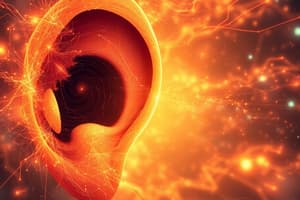Podcast
Questions and Answers
What are the three main parts that the ear is divided into?
What are the three main parts that the ear is divided into?
- Upper ear, middle ear, lower ear
- Left ear, right ear, center ear
- Front ear, back ear, center ear
- Outer ear, middle ear, inner ear (correct)
Which part of the ear is responsible for converting sound vibrations into electrical signals?
Which part of the ear is responsible for converting sound vibrations into electrical signals?
- Middle ear
- Inner ear (correct)
- Outer ear
- Back ear
What structures in the middle ear act as mechanical transmitters of sound?
What structures in the middle ear act as mechanical transmitters of sound?
- Ossicles (correct)
- Springs
- Pins
- Strings
What is the range of human hearing in terms of frequency according to the text?
What is the range of human hearing in terms of frequency according to the text?
What is the lower limit of sensitivity for the ear in terms of pressure waves?
What is the lower limit of sensitivity for the ear in terms of pressure waves?
Which part of the outer ear is shaped to capture sound from the front?
Which part of the outer ear is shaped to capture sound from the front?
Flashcards are hidden until you start studying
Study Notes
The physics of the ear is a fascinating field that explores the mechanics of how our auditory system captures sound vibrations and converts them into electrical signals for the brain to interpret. The ear is divided into three main parts: the outer ear, middle ear, and inner ear. Each part plays a crucial role in the hearing process, and their structures and functions are influenced by evolution.
The outer ear consists of the pinna, or auricle, and the ear canal, which directs sound to the eardrum. The pinna is shaped to capture sound from the front and direct it towards the eardrum, a structure that helped our ancestors focus on sounds emitted by prey. The middle ear contains three small bones known as the ossicles: the malleus, incus, and stapes. These bones act as mechanical transmitters of sound, converting the sound vibrations into electrical signals. The inner ear, which includes the cochlea, is responsible for converting these electrical signals into nerve impulses that are sent to the brain.
One of the most important aspects of the ear's physics is its range of perception. Human hearing can detect sounds from approximately 20Hz to 20KHz, although this range decreases with age. The ear's sensitivity is determined by the pressure waves of sound, with the lower limit being absolute silence at 20μPa and the upper limit beginning at 130dB, where hearing damage can occur.
The ear's primary malfunctions include loss of hearing due to age or exposure to loud sounds, tinnitus (ringing or hissing sounds in the absence of external stimuli), and vertigo (the perception of movement when there is none). These issues are often caused by damage to the ear's structures or the nerves that transmit sound to the brain.
In summary, the physics of the ear is a complex process that involves the conversion of sound vibrations into electrical signals and the transmission of these signals to the brain. This process is influenced by the ear's structure and the physical properties of sound waves, and it is subject to various malfunctions that can impact our ability to hear.
Studying That Suits You
Use AI to generate personalized quizzes and flashcards to suit your learning preferences.




